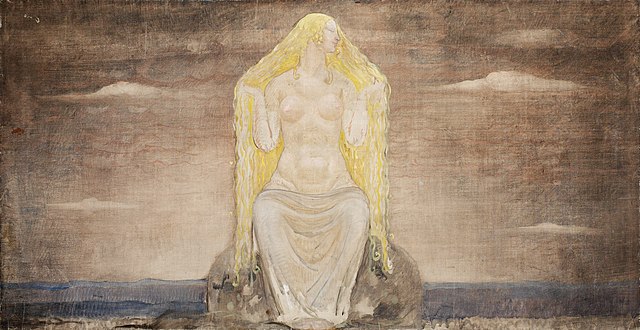In Norse mythology, Brísingamen is the torc or necklace of the goddess Freyja. The name is an Old Norse compound brísinga-men whose second element is men "(ornamental) neck-ring, torc". The etymology of the first element is uncertain. It has been derived from Old Norse brísingr, a poetic term for "fire" or "amber" mentioned in the anonymous versified word-lists (þulur) appended to many manuscripts of the Prose Edda, making Brísingamen "gleaming torc", "sunny torc", or the like. However, Brísingr can also be an ethnonym, in which case Brísinga men is "torque of the Brísings"; the Old English parallel in Beowulf supports this derivation, though who the Brísings may have been remains unknown.
Heimdall returns Brisingamen to Freyja, painting by Nils Blommér (1846).
The pendant, in the Swedish Museum of National Antiquities in Stockholm
In Norse mythology, Freyja is a goddess associated with love, beauty, fertility, sex, war, gold, and seiðr. Freyja is the owner of the necklace Brísingamen, rides a chariot pulled by two cats, is accompanied by the boar Hildisvíni, and possesses a cloak of falcon feathers. By her husband Óðr, she is the mother of two daughters, Hnoss and Gersemi. Along with her twin brother Freyr, her father Njörðr, and her mother, she is a member of the Vanir. Stemming from Old Norse Freyja, modern forms of the name include Freya, Freyia, and Freja.
Freja (1905) by John Bauer (1882–1918)
Freyja and Loki flyte in an illustration (1895) by Lorenz Frølich.
While Freyja's cats look on, the god Thor is unhappily dressed as Freyja in Ah, what a lovely maid it is! (1902) by Elmer Boyd Smith.
Reclining atop her boar Hildisvíni, Freyja visits Hyndla in an illustration (1895) by Lorenz Frølich.






